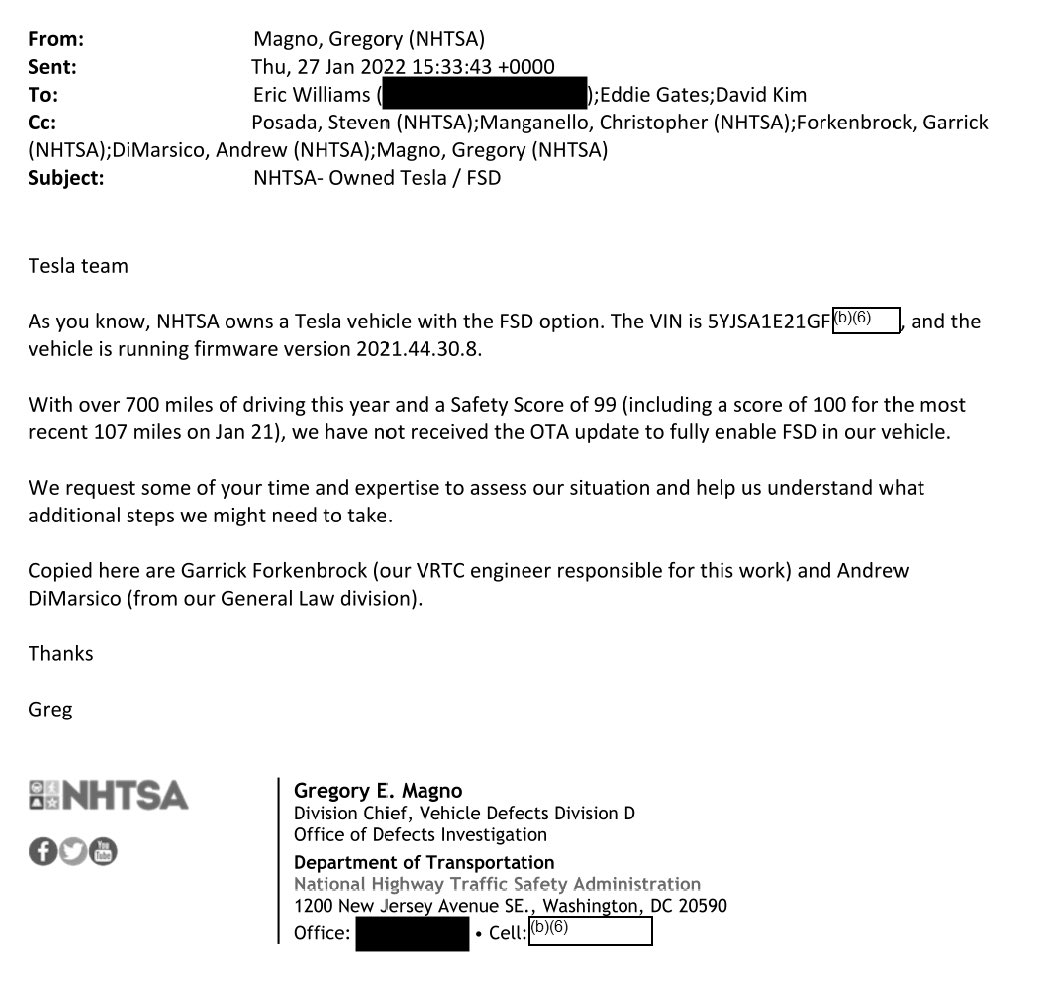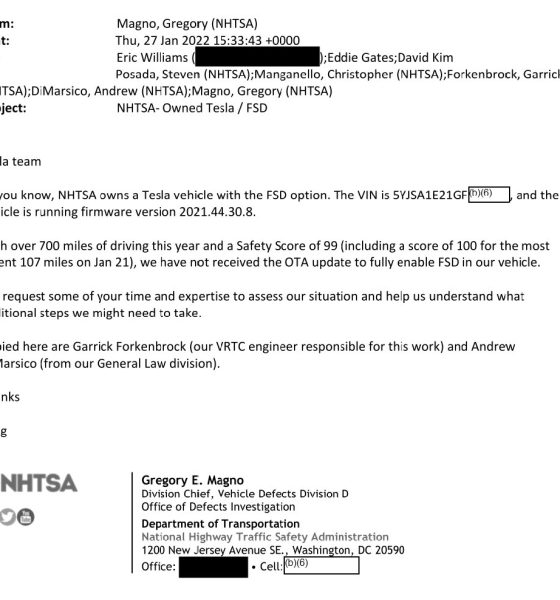Tesla will give the National Highway Transportation Safety Administration (NHTSA) access to FSD Beta, according to a recent tweet from Elon Musk. Elon responded to a tweet from @WholeMarsBlog who pointed out that even the NHTSA was complaining about having to participate in the safety score process that all of Tesla’s FSD Beta testers have to do.
🤣 ok we’ll turn it on
— Elon Musk (@elonmusk) August 16, 2022
In the tweet, @WholeMarsBlog shared a screenshot of a letter from the agency to Tesla that read:
“As you know, NHTSA owns a Tesla vehicle with the FSD option.”
“With over 700 miles of driving this year and a Safety Score of 99 (including a score of 100 for the most recent 107 miles on January 21), we have not received the OTA update to fully enable FSD in our vehicle.”
“We request some of your time and expertise to asses our situation and help us understand what additional steps we might need to take.”
The letter was dated in January 2022 but is now being brought into the public spotlight on Twitter. This comes after some drama over the weekend. The CEO of Green Hills Software and founder of the Dawn Project, Dan O’Dowd, has been relentlessly campaigning against Tesla’s FSD Beta. The billionaire has recently published television ads claiming that Tesla’s FSD Beta is not stopping for children.
These claims have been debunked several times over the weekend and I wrote about two instances. In the first one, I interviewed @TeslaDriver2022 who performed a test with child-sized Amazon boxes.
“The FSD Beta has just been getting better exponentially even since I’ve been using it. Just some of the predictions it’s got and the capabilities to understand when things are getting in their path. Not even that. Some of the most impressive stuff is just when I’m driving down the road at 45 miles an hour and there’s a car that will turn in front of me to get into a parking lot.
“Its ability to understand whether or not that car is gonna make it or not and whether or not it needs to slow down. It’s becoming very human-like.”
In the second article, @WholeMarsBlog tested FSD Beta on a child-sized mannequin and allowed Tad Park to test it on his son. In each test, FSD Beta recognized and stopped for pedestrians. He told me that the test showed that FSD Beta has no problem detecting pedestrians of all ages.
However, critics claim that the Tesla owners are vile for testing it on their children, yet are refusing to acknowledge that O’Dowd’s claims were disproven. The idea of testing such software on a child may seem horrifying to those who don’t understand the software or know how to drive.
A father who loves his child would quickly take over and brake if the software were to refuse to stop. And in the video, you can see clearly see the screen recognizing the child and stopping at a very safe distance.
In O’Dowd’s videos, the screen is hard to see and you can see some type of error message as the driver refuses to disengage. Many in the Tesla community have pointed out that the driver was accelerating. If this is the case, then FSD Beta would have to allow the driver to take over. This includes acceleration.
Aka, something like "Accelerator pedal is pressed – car will not brake" or "Front camera blocked or blinded".
Why do you keep driving with errors? Why do you keep "coincidentally" posting videos with them too blurry to read?
People have been asking you this from Day 1, Dan.
— Nafnlaus 🇮🇸🇺🇦 (@enn_nafnlaus) August 15, 2022
With Tesla granting the NHTSA access to FSD Beta, the agency will most likely do testing of its own. This, I think would be a very good thing considering that the agency and its employees aren’t running for political office for the sole reason of taking down Elon Musk.
The agency and Tesla may have gone head to head a few times, however, safety is important for both Tesla and the NHTSA so it makes sense to grant the agency FSD Beta for its vehicle.
Disclaimer: Johnna is long Tesla.
I’d love to hear from you! If you have any comments, concerns, or see a typo, you can email me at johnna@teslarati.com. You can also reach me on Twitter @JohnnaCrider1

News
Tesla FSD fleet is nearing 7 billion total miles, including 2.5 billion city miles
As can be seen on Tesla’s official FSD webpage, vehicles equipped with the system have now navigated over 6.99 billion miles.

Tesla’s Full Self-Driving (Supervised) fleet is closing in on almost 7 billion total miles driven, as per data posted by the company on its official FSD webpage.
These figures hint at the massive scale of data fueling Tesla’s rapid FSD improvements, which have been quite notable as of late.
FSD mileage milestones
As can be seen on Tesla’s official FSD webpage, vehicles equipped with the system have now navigated over 6.99 billion miles. Tesla owner and avid FSD tester Whole Mars Catalog also shared a screenshot indicating that from the nearly 7 billion miles traveled by the FSD fleet, more than 2.5 billion miles were driven inside cities.
City miles are particularly valuable for complex urban scenarios like unprotected turns, pedestrian interactions, and traffic lights. This is also the difference-maker for FSD, as only complex solutions, such as Waymo’s self-driving taxis, operate similarly on inner-city streets. And even then, incidents such as the San Francisco blackouts have proven challenging for sensor-rich vehicles like Waymos.
Tesla’s data edge
Tesla has a number of advantages in the autonomous vehicle sector, one of which is the size of its fleet and the number of vehicles training FSD on real-world roads. Tesla’s nearly 7 billion FSD miles then allow the company to roll out updates that make its vehicles behave like they are being driven by experienced drivers, even if they are operating on their own.
So notable are Tesla’s improvements to FSD that NVIDIA Director of Robotics Jim Fan, after experiencing FSD v14, noted that the system is the first AI that passes what he described as a “Physical Turing Test.”
“Despite knowing exactly how robot learning works, I still find it magical watching the steering wheel turn by itself. First it feels surreal, next it becomes routine. Then, like the smartphone, taking it away actively hurts. This is how humanity gets rewired and glued to god-like technologies,” Fan wrote in a post on X.
News
Tesla starts showing how FSD will change lives in Europe
Local officials tested the system on narrow country roads and were impressed by FSD’s smooth, human-like driving, with some calling the service a game-changer for everyday life in areas that are far from urban centers.

Tesla has launched Europe’s first public shuttle service using Full Self-Driving (Supervised) in the rural Eifelkreis Bitburg-Prüm region of Germany, demonstrating how the technology can restore independence and mobility for people who struggle with limited transport options.
Local officials tested the system on narrow country roads and were impressed by FSD’s smooth, human-like driving, with some calling the service a game-changer for everyday life in areas that are far from urban centers.
Officials see real impact on rural residents
Arzfeld Mayor Johannes Kuhl and District Administrator Andreas Kruppert personally tested the Tesla shuttle service. This allowed them to see just how well FSD navigated winding lanes and rural roads confidently. Kruppert said, “Autonomous driving sounds like science fiction to many, but we simply see here that it works totally well in rural regions too.” Kuhl, for his part, also noted that FSD “feels like a very experienced driver.”
The pilot complements the area’s “Citizen Bus” program, which provides on-demand rides for elderly residents who can no longer drive themselves. Tesla Europe shared a video of a demonstration of the service, highlighting how FSD gives people their freedom back, even in places where public transport is not as prevalent.
What the Ministry for Economic Affairs and Transport says
Rhineland-Palatinate’s Minister Daniela Schmitt supported the project, praising the collaboration that made this “first of its kind in Europe” possible. As per the ministry, the rural rollout for the service shows FSD’s potential beyond major cities, and it delivers tangible benefits like grocery runs, doctor visits, and social connections for isolated residents.
“Reliable and flexible mobility is especially vital in rural areas. With the launch of a shuttle service using self-driving vehicles (FSD supervised) by Tesla in the Eifelkreis Bitburg-Prüm, an innovative pilot project is now getting underway that complements local community bus services. It is the first project of its kind in Europe.
“The result is a real gain for rural mobility: greater accessibility, more flexibility and tangible benefits for everyday life. A strong signal for innovation, cooperation and future-oriented mobility beyond urban centers,” the ministry wrote in a LinkedIn post.
News
Tesla China quietly posts Robotaxi-related job listing
Tesla China is currently seeking a Low Voltage Electrical Engineer to work on circuit board design for the company’s autonomous vehicles.

Tesla has posted a new job listing in Shanghai explicitly tied to its Robotaxi program, fueling speculation that the company is preparing to launch its dedicated autonomous ride-hailing service in China.
As noted in the listing, Tesla China is currently seeking a Low Voltage Electrical Engineer to work on circuit board design for the company’s autonomous vehicles.
Robotaxi-specific role
The listing, which was shared on social media platform X by industry watcher @tslaming, suggested that Tesla China is looking to fill the role urgently. The job listing itself specifically mentions that the person hired for the role will be working on the Low Voltage Hardware team, which would design the circuit boards that would serve as the nervous system of the Robotaxi.
Key tasks for the role, as indicated in the job listing, include collaboration with PCB layout, firmware, mechanical, program management, and validation teams, among other responsibilities. The role is based in Shanghai.
China Robotaxi launch
China represents a massive potential market for robotaxis, with its dense urban centers and supportive policies in select cities. Tesla has limited permission to roll out FSD in the country, though despite this, its vehicles have been hailed as among the best in the market when it comes to autonomous features. So far, at least, it appears that China supports Tesla’s FSD and Robotaxi rollout.
This was hinted at in November, when Tesla brought the Cybercab to the 8th China International Import Expo (CIIE) in Shanghai, marking the first time that the autonomous two-seater was brought to the Asia-Pacific region. The vehicle, despite not having a release date in China, received a significant amount of interest among the event’s attendees.










